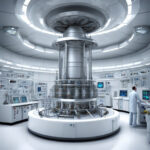China’s Breakthrough in Nuclear Fusion: Unlocking the Universe’s Heaviest Elements
Researchers at Xi’an Jiaotong University in China have found a novel approach to synthesizing superheavy elements by using an argon-fueled nuclear fusion method. This groundbreaking discovery could revolutionize the field of nuclear physics and unlock the secrets of the universe’s heaviest elements.
Nuclear fusion is the process that powers the sun and other stars, where light atomic nuclei combine to form heavier nuclei, releasing vast amounts of energy in the process. Scientists have long sought to replicate this process on Earth as a clean and virtually limitless source of energy. However, achieving controlled fusion reactions has proven to be a significant challenge due to the high temperatures and pressures required to overcome the electrostatic repulsion between positively charged nuclei.
The team of researchers at Xi’an Jiaotong University has taken a unique approach to nuclear fusion by using argon as a fuel source. Argon, a noble gas, is abundant on Earth and is relatively inert, making it an ideal candidate for fusion experiments. By using argon as a fuel, the researchers were able to create stable plasma conditions at lower temperatures and pressures than traditional fusion methods, making the process more efficient and sustainable.
One of the most significant implications of this discovery is its potential to produce superheavy elements, which are not found in nature and can only be created in a laboratory setting. These elements, such as einsteinium and fermium, are located at the far end of the periodic table and are incredibly unstable, decaying rapidly through radioactive decay. By harnessing the power of argon-fueled fusion, scientists may be able to synthesize and study these elusive elements, shedding light on the fundamental forces that govern the universe.
In addition to advancing our understanding of nuclear physics, the argon-fueled fusion method could also have practical applications in energy production. By optimizing fusion reactions with argon fuel, researchers may be able to develop more efficient and cost-effective fusion reactors that could one day power homes and industries with clean, sustainable energy.
While the research is still in its early stages, the potential of China’s argon-fueled nuclear fusion method to unlock the universe’s heaviest elements is truly exciting. By pushing the boundaries of scientific knowledge and technological innovation, researchers are paving the way for a future where clean energy and fundamental discoveries go hand in hand.
In conclusion, China’s breakthrough in nuclear fusion using argon as a fuel source represents a significant step forward in the quest to unlock the universe’s heaviest elements. This innovative approach not only holds promise for advancements in nuclear physics but also in the development of sustainable energy solutions for the future.
fusion, nuclear, elements, China, research












